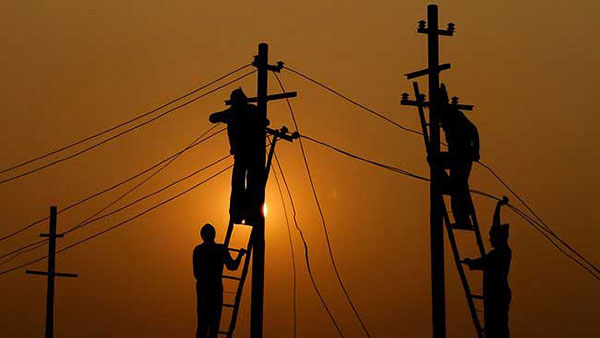At PEaCE/ECPAT Sri Lanka, we have recently improved our documentation system by introducing expanded classifications. We have aligned our data collection methods with UNICEF’s International Classification of Violence Against Children (ICVAC) standards. This comprehensive approach allows us to detail and categorise information from various media sources. As a result, our analysis now spans multiple pages to accommodate the wealth of compiled data. To enhance user experience, we have created a summary highlighting essential insights to guide readers through the comprehensive documentation. This condensed version aims to provide a clear understanding and facilitate engagement with the content.
According to the reported incidents of violence against children in February 2024, sexual abuse emerged as the most prevalent form of violence against children, accounting for 37% of reported incidents and affecting 29% of victims. Physical abuse is also distressingly common, with 14% of reported incidents and 24% of victims experiencing this form of violence. Neglect, although often overlooked, is another significant issue affecting children, with 16% of reported incidents and just over 20% of victims experiencing some form of neglect. Emotional abuse, homicide and other forms of violence also contribute to the alarming prevalence of violence against children. It is clear from the data that multiple forms of violence are intertwined, with some children experiencing numerous forms of abuse simultaneously.

The data on the gender of victims of violence against children for February reveals some critical insights. Females comprised the majority of incidents, accounting for 39 of reported cases, with 40% female victims. This suggests that girls are often targeted in incidents of violence against children. Further, the data shows that males accounted for 29% of incidents and 26% of victims, indicating that boys are also significantly impacted by violence. A concerning finding in the data is the high number of unspecified gender cases. In February, there were 13 incidents where the gender of the victim was unspecified, making up 18% of the total incidents reported and 35% of the total number of victims. This lack of gender-specific information hinders a comprehensive understanding of the gender dynamics of violence against children.
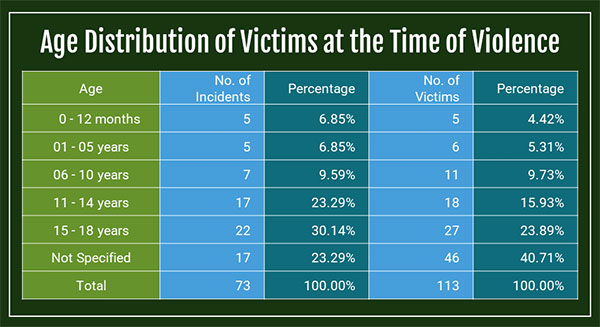
The data presented shows the age distribution of children subjected to various forms of violence during February 2024. Children aged 15 – 18 accounted for the most incidents at 30%, followed closely by children aged 11- 14 at 23%. Further, the victims’ percentage was highest among children aged 15 – 18 at 24%, with those aged 11 – 14 following at 16%. Moreover, the age group “Not specified” had a high percentage of incidents and victims at 23% and 41%, respectively, highlighting the need for better documentation and reporting of such cases.
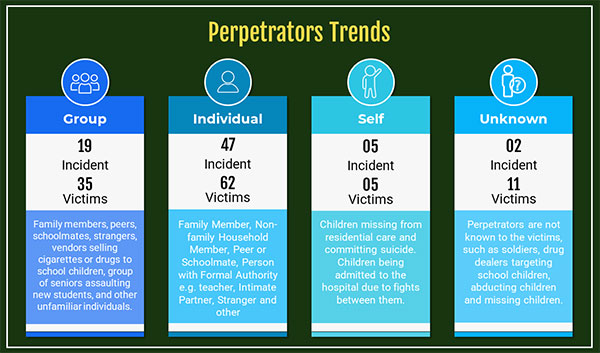
The analysis of the Perpetrator Trends in Reported Incidents of violence against children reveals the below patterns. The majority of incidents (64%) involved individuals as perpetrators, which included a wide range of relationships such as family members, non-family household members, peers, persons with formal authority (e.g. teachers), intimate partners and even strangers. This highlights the reality that children are often at risk of violence from those closest to them, as well as from individuals in positions of power or trust.
On the other hand, a notable portion of incidents (26%) involved groups as perpetrators, which could include multiple perpetrators from different categories, such as family members, peers, schoolmates and strangers. This suggests that in some cases, children may face violence from various sources simultaneously, making them even more vulnerable and in need of protection. It is also concerning that there were many incidents (10%) where the perpetrator was unknown. This could indicate challenges in identifying and holding perpetrators accountable, as well as a lack of information on the circumstances surrounding the violence. Also, there were incidents where children inflicted harm on themselves, either through missing or suicide attempts. This highlights the importance of addressing not only external threats to children’s safety but also their mental health and well-being to prevent incidents of self-harm..
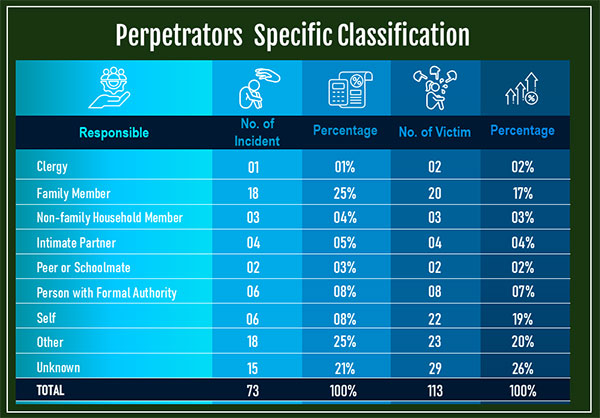
The data presented above provides insights into the specific perpetrators involved in reported incidents of violence against children. It is essential to note that the perpetrators belong to various categories, each with its own unique characteristics and implications.
The data shows that family members account for 25% of the perpetrators, with fathers, mothers, parents or adoptive parents, siblings, cousins and other relatives being involved in the abuse of children. Approximately 4% of the perpetrators are non-family household members, including the mother’s paramour.
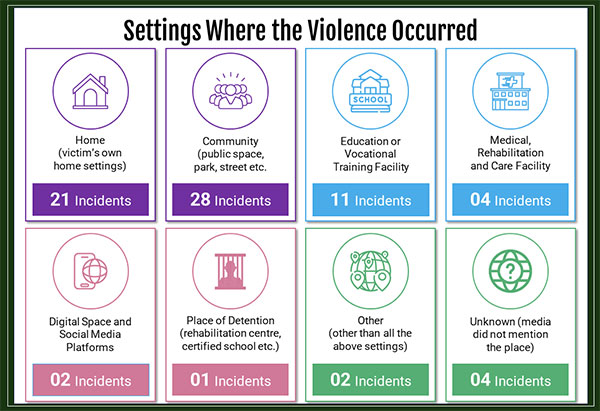
Perpetrators who are intimate partners of the victim account for 5% of reported incidents. This underscores the prevalence of domestic violence and its impact on children within the family setting. 8% of the perpetrators are individuals with formal authority, such as teachers or school administrators. In 8% of reported incidents, the perpetrator is identified as the victim themselves. This may indicate instances of self-harm or self-inflicted violence, emphasising the need for mental health support and intervention for children experiencing such distress. A notable 21% of reported incidents involve perpetrators whose identity is unknown. The data also shows that 25% of reported incidents involve perpetrators categorised as “other,” reflecting a diverse range of individuals or situations contributing to violence against children.
The data on settings where violence occurred presents various locations where incidents occurred. The highest reported setting was in the community, with 28% of incidents occurring in public spaces such as religious worship places, streets and parks. Education or vocational training facilities were another significant setting, with 11% of incidents occurring in these locations. The home was also identified as a prevalent setting for violence, with 21% of incidents occurring within the household. Moreover, the data shows that digital spaces and social media platforms accounted for 2% of reported incidents. As technology plays a significant role in our daily lives, addressing the challenges of violence in online spaces and developing strategies to promote online safety are crucial.
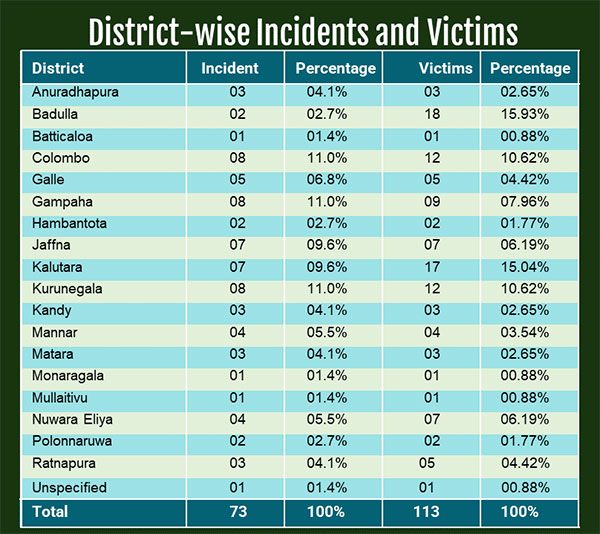
A notable observation from the data is the varying degrees of violence across different districts. Colombo, Gampaha and Kalutara stand out as districts with relatively higher numbers of incidents and victims than others. These densely populated urban areas seem to be more prone to violence, possibly due to factors like higher crime rates and socioeconomic disparities. On the other hand, some districts like Batticaloa, Monaragala, and Mullaitivu have lower numbers of incidents and victims and possibly lower population densities in these areas.





